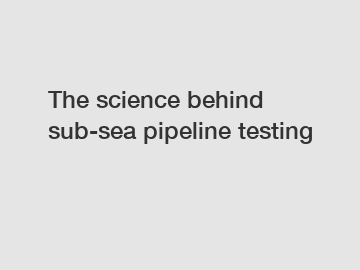The science behind sub-sea pipeline testing
The Science Behind Sub-Sea Pipeline Testing.
Sub-sea pipelines play a crucial role in our global energy infrastructure. These pipelines transport oil, gas, and other essential resources from offshore production facilities to onshore processing plants. Given their vital importance, it is crucial to ensure that these pipelines are tested thoroughly to guarantee their safety and reliability. In this article, we will dive into the science behind sub-sea pipeline testing, highlighting the methods and technologies used to detect and prevent potential issues.
Hydrostatic Testing: Ensuring Structural Integrity.

One of the primary methods employed for sub-sea pipeline testing is hydrostatic testing. This technique involves filling the pipeline with water and pressurizing it to levels above its operating pressure. By subjecting the pipeline to higher pressure levels, hydrostatic testing can determine its structural integrity and ability to withstand extreme conditions. .
During hydrostatic testing, specialized equipment is utilized to monitor the pipeline for any signs of leakage or weakness. This equipment includes pressure gauges, acoustic sensors, and ultrasonic devices. Any anomalies detected during the testing process can be promptly addressed to prevent potential failures in actual operating conditions.
Pipeline Pigging: Maintaining Efficiency and Quality.
Another essential aspect of sub-sea pipeline testing is the use of pipeline pigs. A pipeline pig is a device inserted into the pipeline and propelled by the flow of product or a separate propellant. Pipeline pigs serve several purposes, including cleaning and maintaining the integrity of the pipeline.
The use of smart pigs equipped with advanced sensors allows operators to detect various issues, such as corrosion, cracks, and deformities, within the pipeline walls. By collecting and analyzing data from these sensors, engineers can assess the condition of the pipeline and take preventive measures to ensure its optimal performance. Pigging is crucial not only for safety reasons but also for maintaining efficiency, as it helps to prevent flow restrictions and reduce operational costs.
Non-Destructive Testing: Uncovering Hidden Flaws.
When it comes to sub-sea pipeline testing, non-destructive testing (NDT) techniques come into play. NDT methods allow engineers to inspect the integrity of pipelines without causing damage or disruption to the system. These methods include magnetic particle inspection, ultrasonic testing, radiographic testing, and eddy current testing.
Magnetic particle inspection involves applying a magnetic field to the pipeline and scattering magnetic particles on its surface. By examining the particles' behavior, engineers can detect any cracks or defects within the material. Ultrasonic testing utilizes high-frequency sound waves to inspect the pipeline's thickness, while radiographic testing employs X-rays or gamma-rays to detect flaws hidden within the pipeline. Eddy current testing is used to identify corrosion and other defects on the surface of the pipeline.
Conclusion:
The science behind sub-sea pipeline testing is a combination of various techniques and technologies aimed at ensuring the safety and reliability of these vital infrastructure components. Hydrostatic testing, pipeline pigging, and non-destructive testing methods play significant roles in identifying potential issues and preventing failures. Through these rigorous testing processes, engineers can detect and address any flaws, ensuring that sub-sea pipelines operate efficiently while minimizing the risk of accidents or environmental damage.
If you require sub-sea pipeline testing services or have any related inquiries, please do not hesitate to contact us. Our team of experts will be more than happy to assist you in ensuring the integrity and safety of your pipelines.
The company is the world’s best Sub-sea Pipeline Testing Service Supplier, Retro Jetting, Flange Management Services supplier. We are your one-stop shop for all needs. Our staff are highly-specialized and will help you find the product you need.


